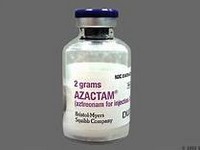Aztreonam
CLINICAL USE
Antibacterial agent
DOSE IN NORMAL RENAL FUNCTION
PHARMACOKINETICS
DOSE IN RENAL IMPAIRMENT
GFR (mL/MIN)
30–50 Dose as in normal renal function10–30 1–2 g loading dose, then maintenance of 50% of appropriate normal dose
DOSE IN PATIENTS UNDERGOING RENAL REPLACEMENT THERAPIES
IMPORTANT DRUG INTERACTIONS
Potentially hazardous interactions with other drugsPossibly enhanced anticoagulant effect of coumarins
ADMINISTRATION
Reconstition
3 mL of water for injection per 1 g vial
Route
IM, IV bolus,
IV infusion
Rate of Administration
IM injection: Give by deep injection into a large muscle massIV: Slowly inject directly into the vein over a period of 3–5 minutes
IV infusion
: Give over 20–60 minutes
Comments
Suitable infusion solutions: glucose 5%, sodium chloride 0.9%, compound sodium lactateDilute to a concentration of not less than 20 mg/mLOnce reconstituted aztreonam can be stored in a refrigerator for 24 hoursIV route recommended for single doses >1 g
OTHER INFORMATION
Manufacturers recommend that patients with renal impairment be given the usual initial dose followed by a maintenance dose adjusted according to creatinine clearance.
